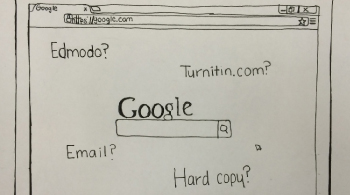Wait, it wasn’t supposed to be emailed?: Students concerned with submission of school work

Most people will tell you they have turned a paper in the wrong way at least once in their learning career. This includes turning something in late and where the assignment needs to be turned in. Let’s say a student finished a big project that was due at 11:59 p.m. The student turns in the project, on time, the night before, through Email, but then come to school the next morning only to have their teacher tell them she never received it. It turns out the project was due on Turnitin.com and you just skimmed over that part of the directions.
Yes, there would have been other ways to stop this problem from even happening, but, it would have been easier if you didn’t need to be told where assignments needed to be turned in. If it was just a tradition that every assignment was turned in the same way to every teacher for grading, it would stop a lot of unneeded half credit or no credit papers.
Turning assignments in the same way would be a good plan, but the problem would be finding the perfect way to turn classwork in. Right now, teachers use an assortment of ways to have work due.
“I have used Email, Turnitin, Edmodo, Google Classroom, and hard copy,” Mrs. Valarie Marburger said.
Why do the teachers include so many ways of turning things in? They all seem to have the same answer for that.
“Each system has their advantages and disadvantages. Email is immediate so I can see who has and hasn’t turned in their assignments, particularly late assignments. With Turnitin, I sometimes forget to check for late assignments, but I can check for copying or plagiarizing with the originality markers,” Mrs. Blaire Lasko said.
There is no way of turning something in has any more or less advantages than another, but with technology rising and online source of turning in assignments may become the best and maybe the only way.
“An Internet-based site would be the best in my opinion, but it’s difficult to get all the teachers to agree on one web based site, since they all seem to handle assignments differently,” Marburger said.
Every teacher has a specific or favorite way of turning in assignments. Every student has about eight different classes with eight different teachers each with a favorite way of receiving students’ work. That comes to a total of eight different ways something could possibly be due for a class. With a universal way of turning something in, that’s only one way for each and every student to have to worry about.
It would be only normal for each teacher to have a different idea on a specific way for papers to be turned in, in school, thus making it hard to find one they all can use. Most teachers think the idea could possibly turn out good for the grading process.
“In theory, it would be nice, but I think there would be issues. Every teacher has a preference, and some teachers have several preferences depending on the assignment,” Lasko said.
At the same time we would be taking the easy way out on a problem that students will have in the future.
“I don’t think we should have [a universal way to turn assignments in]. I think it’s a valuable life experience to learn, as adults, different people will have different expectations from you, and you have to learn to juggle those expectations,” Lasko said.
A universal way to turn something in could be good for you and your grades, but would the amount of possible problems that could follow really be worth it? One problem could be the size of assignment. If it’s photoshop, the files would be too big to upload on some websites and would need to be Emailed. One thing is for sure though: unless the administration gets the idea to have this plan go to action, the teachers will continue to use multiple ways of turning assignments in as long as certain factors appeal to the assignments certain needs.


